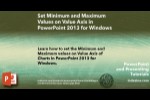Syndicated columnist Stephen Wilbers offers training seminars in effective business writing.
Author: Dr. Stephen Wilbers
Product/Version: PowerPoint

Stephen Wilbers is a keynote speaker, speech coach, and award-winning author. He has offered training seminars in effective writing to more than 10,000 business, technical, legal, academic, and creative writers.
His clients include Mayo Clinic, Medtronic, 3M, Xcel, the Metropolitan Airports Commission, the Metropolitan Council, U.S. Bank, AgCountry Farm Credit Services, Cargill, Mortenson, Ryan Companies, Thomson Reuters, the Wilder Foundation, the Bush Foundation, Fredrikson & Byron, Dorsey & Whitney, the Minnesota State Bar Association, the Pennsylvania Bar Institute, and the Oregon State Bar Association.
You can visit his web page.
I have a friend who has doubts about PowerPoint presentations. He likes to express those doubts by giving a talk entitled, "Where's the power? What's the point?"
His point: If you have nothing worthwhile to say, dressing it up in fancy slides with swooping text and glitzy sound effects won't help. Substance is what counts.
As a presenter, I like using PowerPoint. Although I don't like having the slides in a fixed sequence, and I worry that dimming the lights will give my audience unneeded assistance in falling asleep, I do like the way PowerPoint enables me to emphasize and illustrate my points with highlighted text, graphs, and photos. There's something about those big, fat, color letters that makes the words more interesting.
Here's my advice, from a writer's point of view, on how to use PowerPoint effectively:
Reduce your paragraphs to sentences, and your sentences to keywords. For transparencies, there was the old rule of 36 – no more than six lines of text and six words per line. With PowerPoint, we should probably modify that rule to the rule of 40 – no more than five bulleted items and eight words per line.
Your viewer, like your reader, expects consistency. If you break your pattern, you break your promise. Note, for example, the effect of this sentence: "She was healthy, wealthy, and an athlete."
If the first item in your bulleted list begins with a verb, every item must begin with a verb. If your first item is a sentence fragment, every item must be a sentence fragment.
Nowhere is a nonparallel structure more painfully evident than in PowerPoint.
Remember, it's your words that count. Use a simple template that doesn't overpower your text. Choose a design that makes the words stand out rather than one that obscures them.
Chartjunk refers to too much of a good thing. If you use a plethora of highlighting techniques, too many colors, too many sizes and types of fonts, you create a jumble rather than an orderly pattern that directs your viewers' attention to your key points.
Likewise, use builds, transitions, animation, and sound effects sparingly. My preference is to use no sound effects and to have text simply appear rather than have it swoop or fly in or materialize in checkerboard fashion.
Use nothing smaller than 24-point, bold typeface, and use contrast and colors for emphasis. Note that different projectors may alter your color scheme slightly and wash out your colors, so don't rely solely on colors to distinguish your points. Also, avoid using green and red for contrast because color-blind viewers cannot distinguish those colors.
Finally, never forget to ask the key questions: Where's the power? What's the point? Ten times zero is still zero.
Writing for Business - Copyright by Dr. Stephen Wilbers - First published by the Minneapolis Star Tribune: June 4, 2004



Microsoft and the Office logo are trademarks or registered trademarks of Microsoft Corporation in the United States and/or other countries.